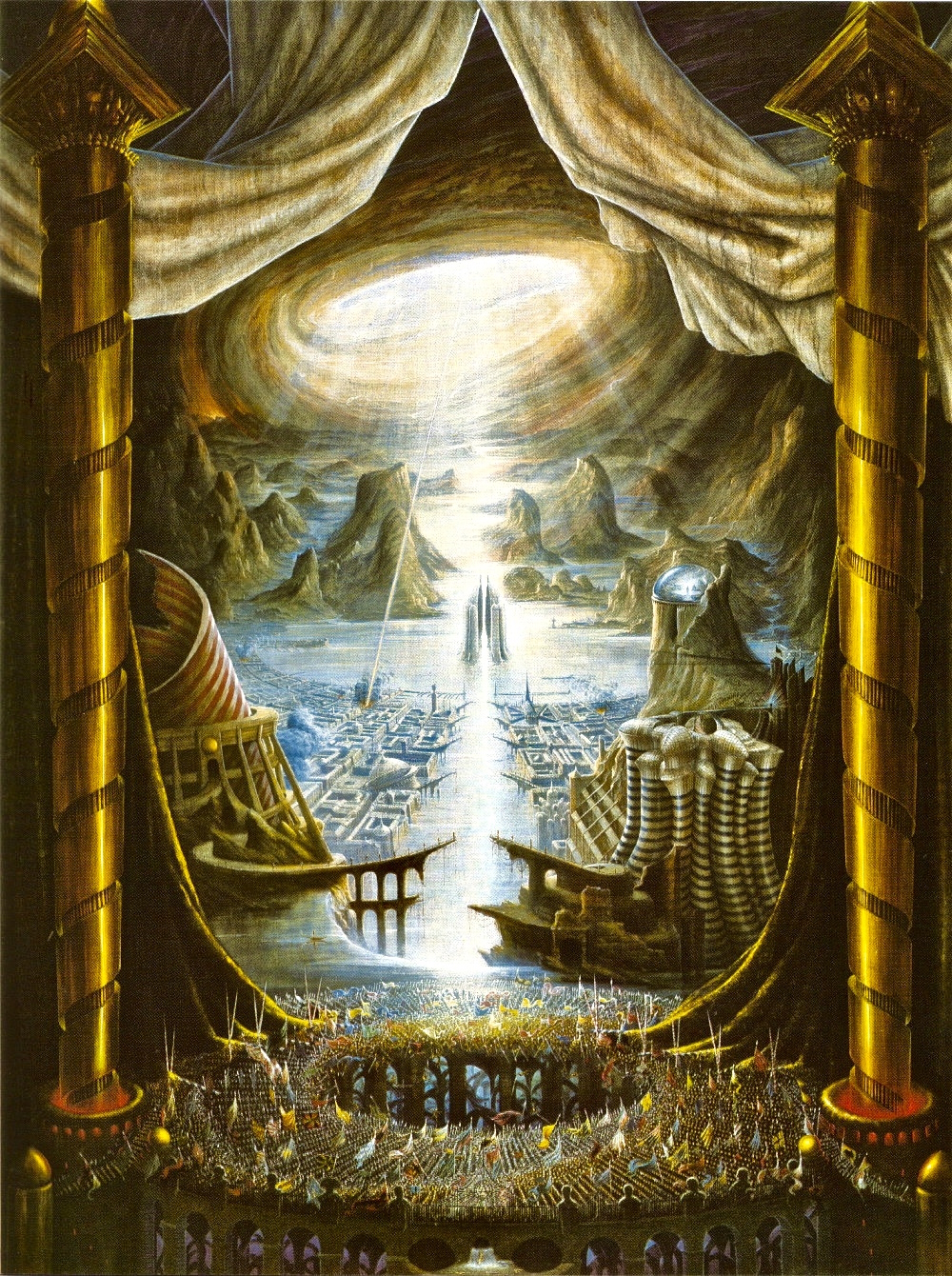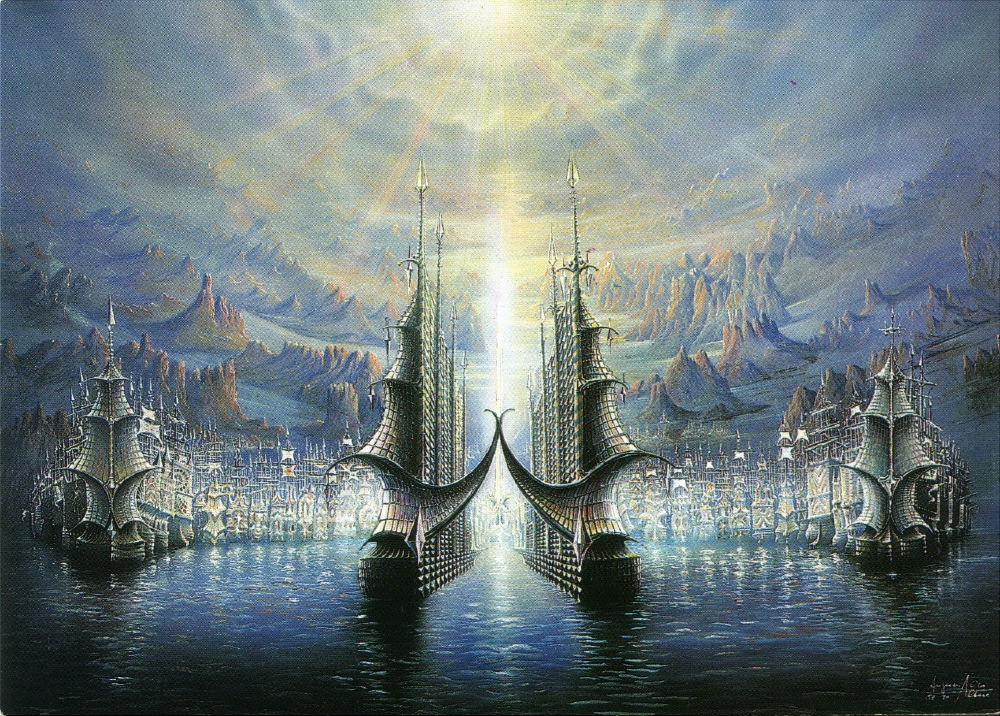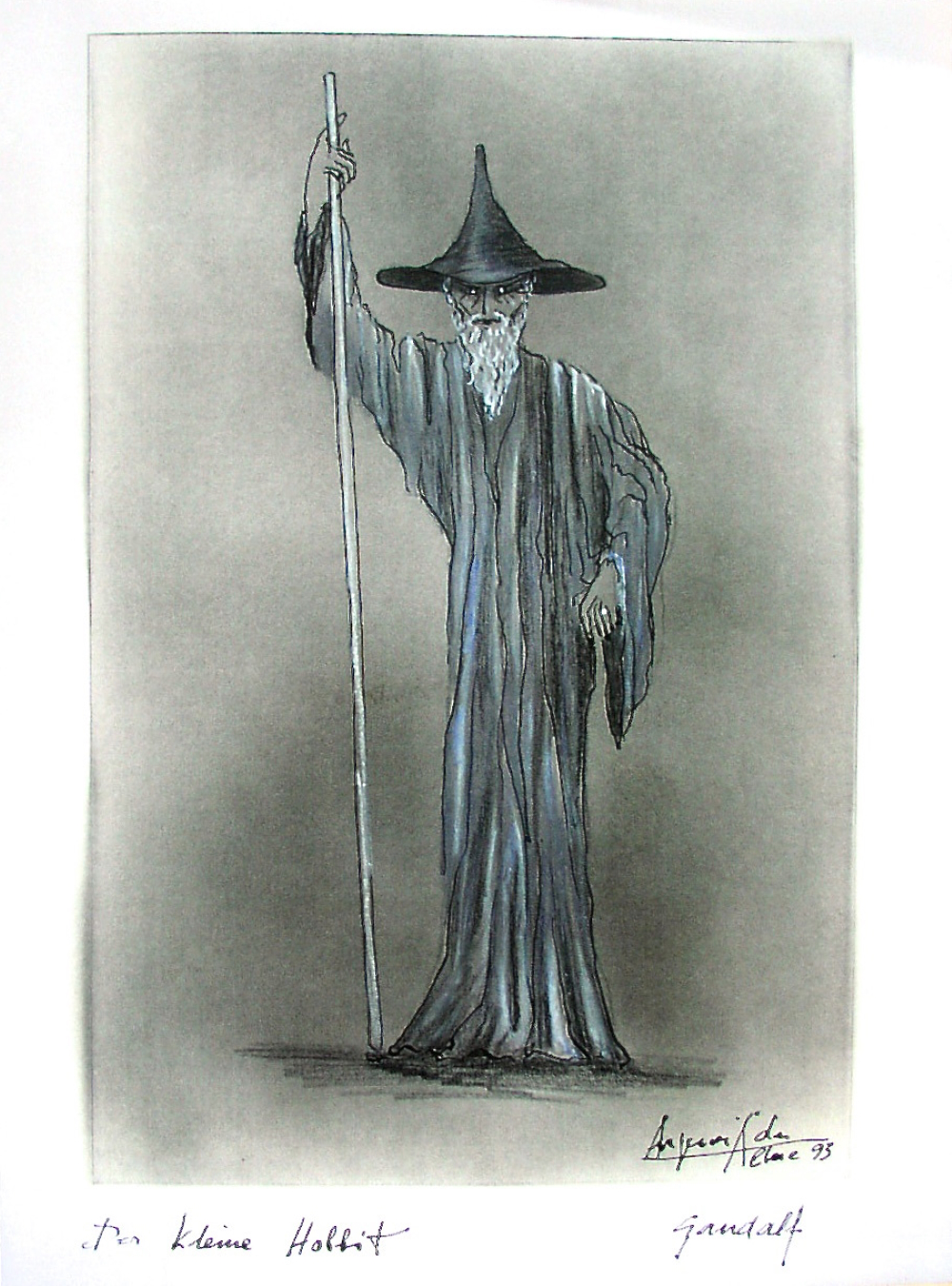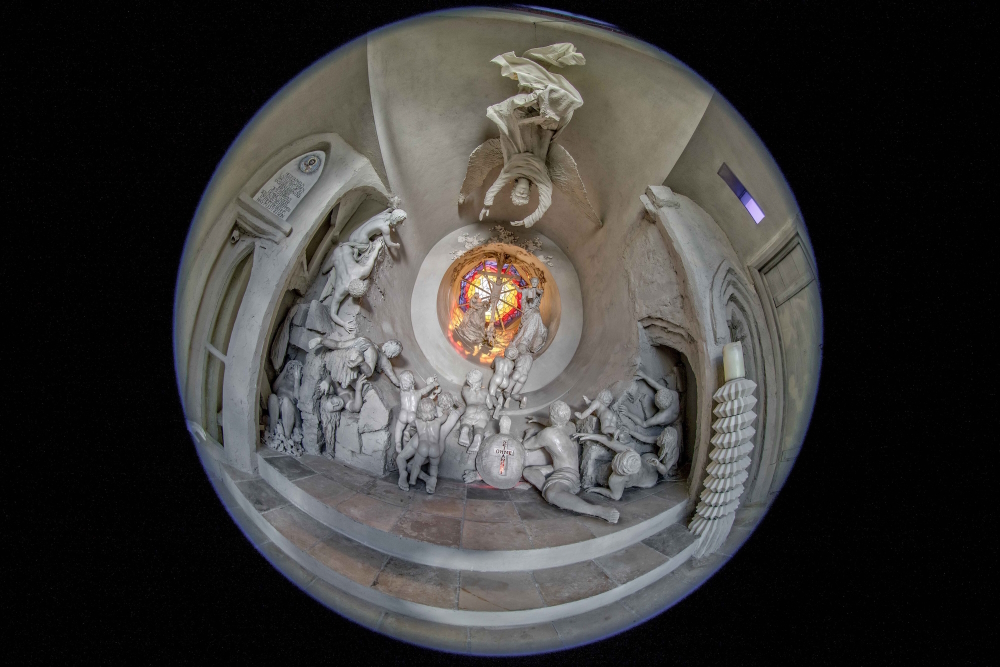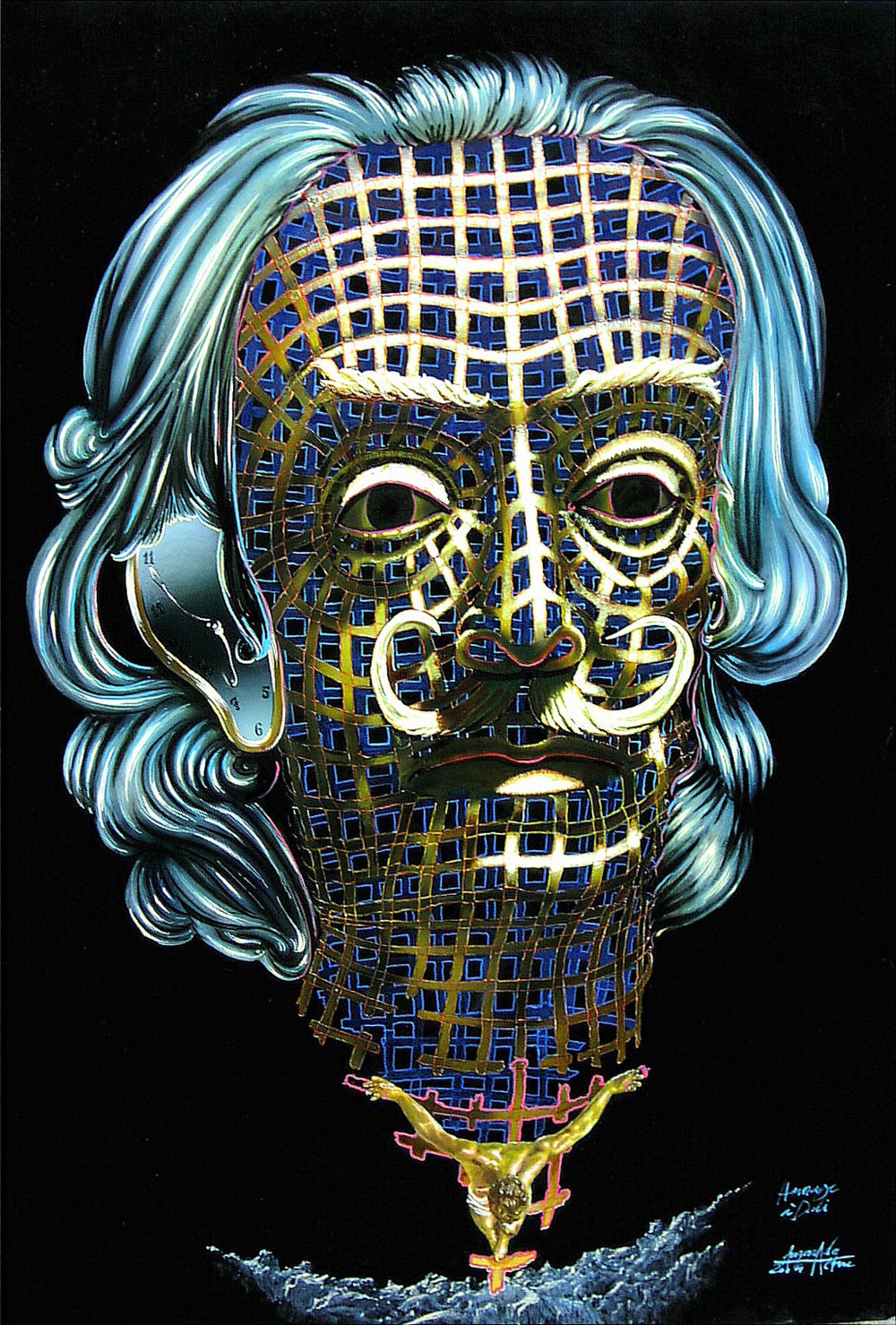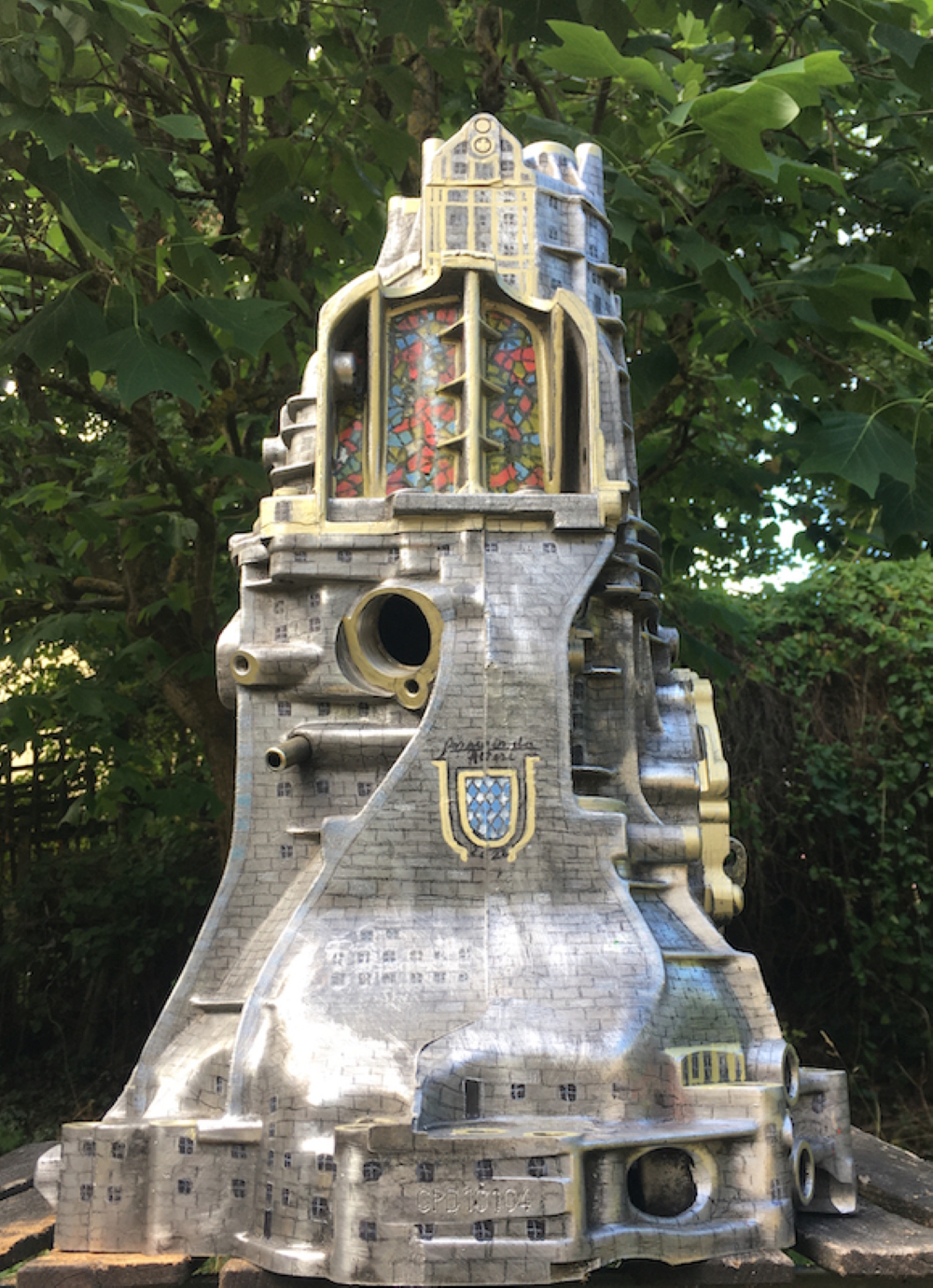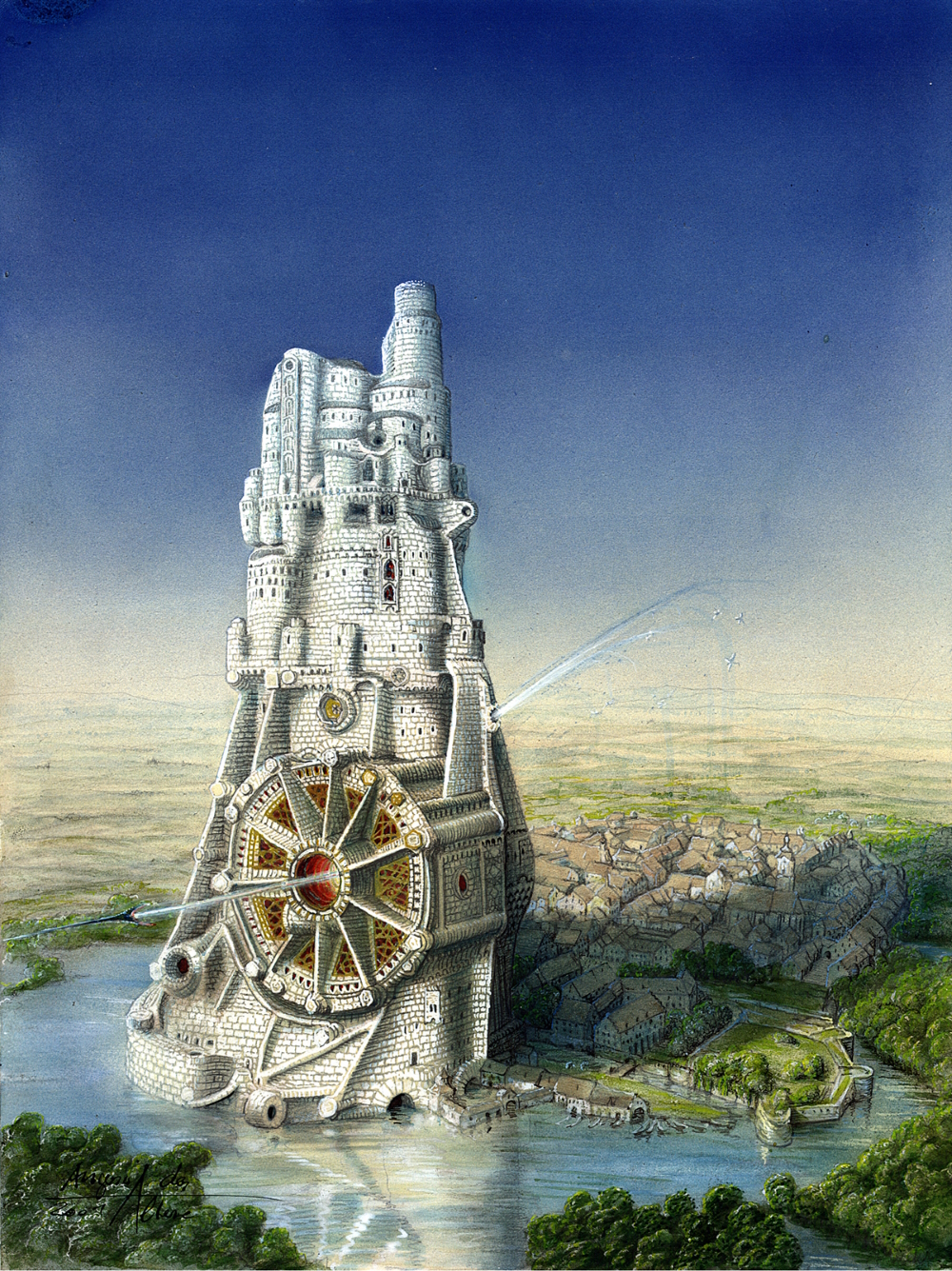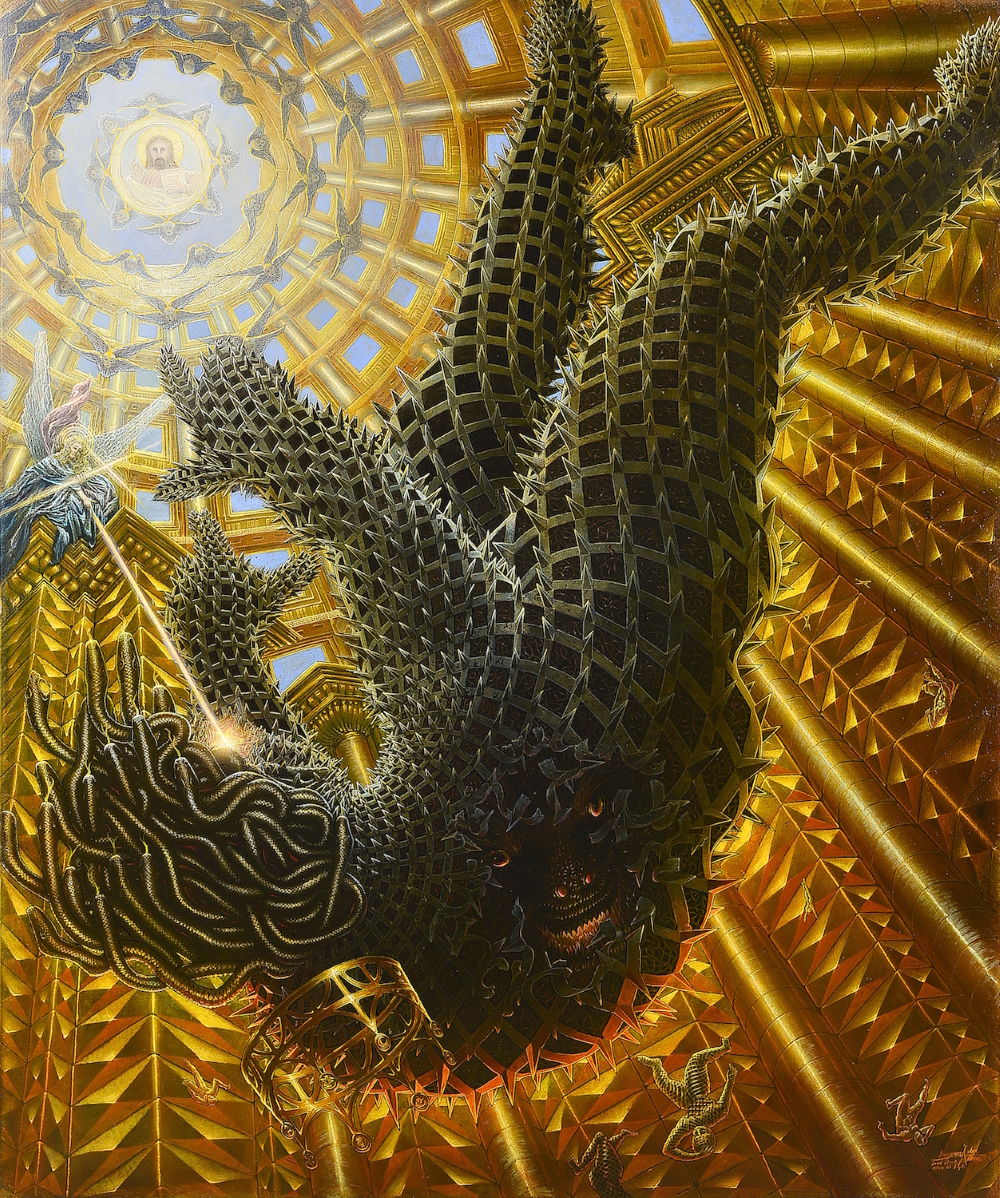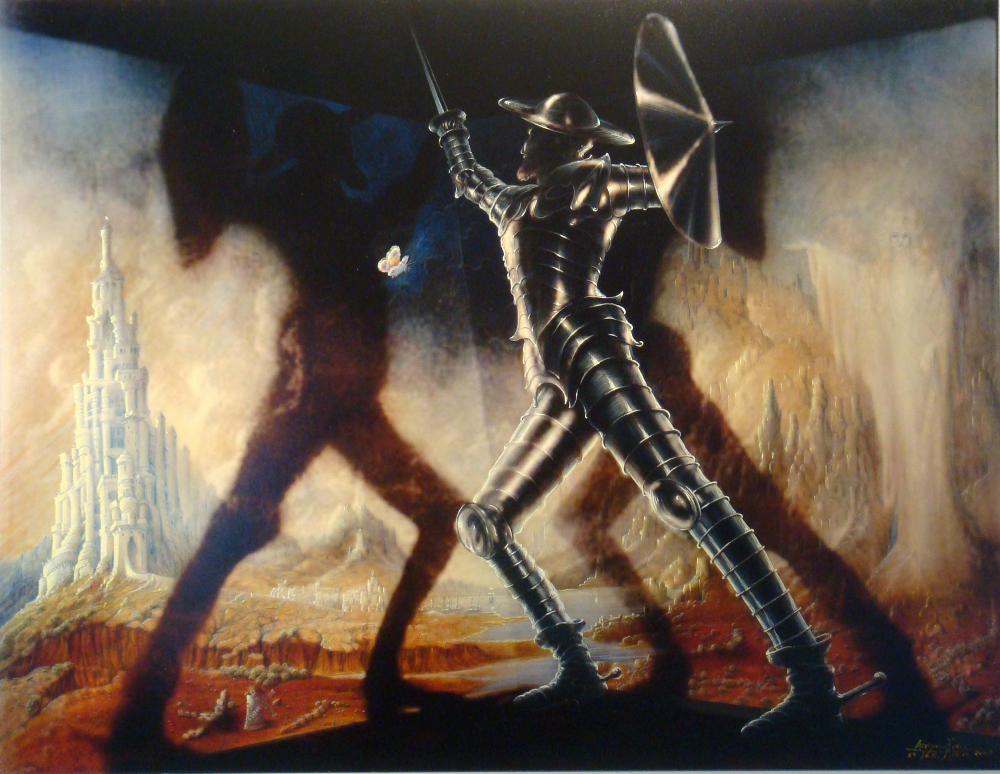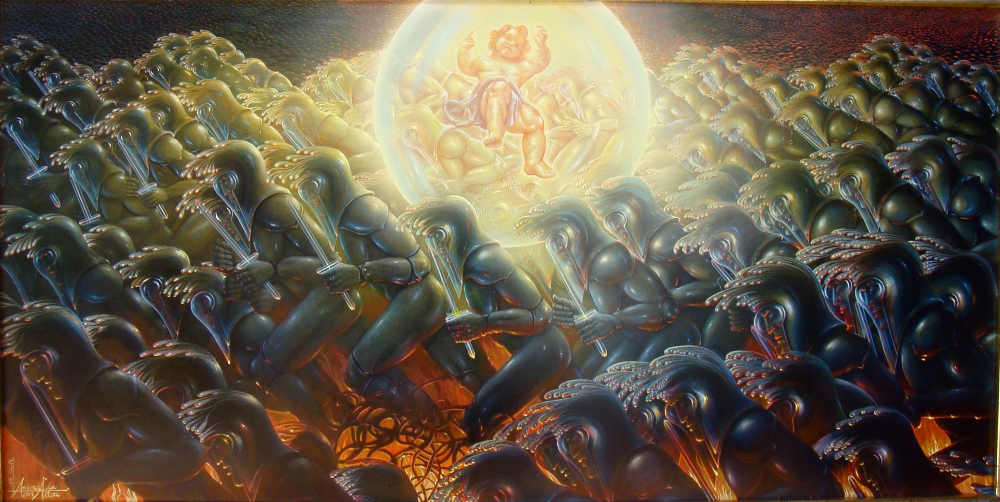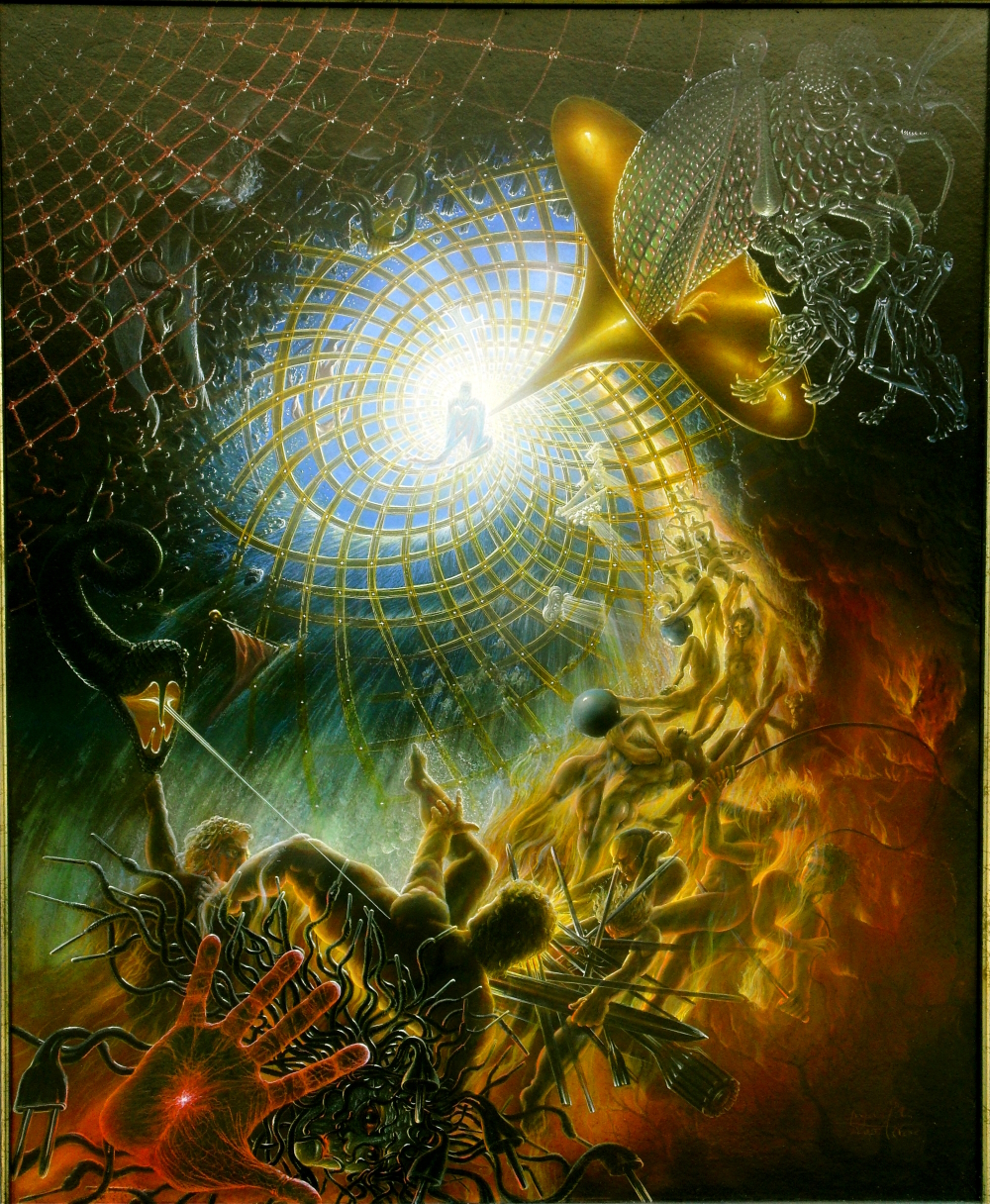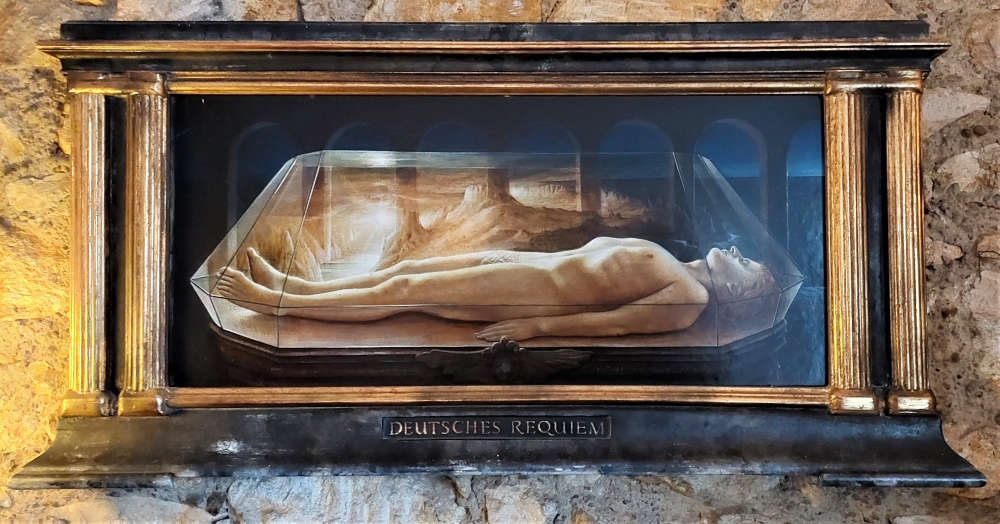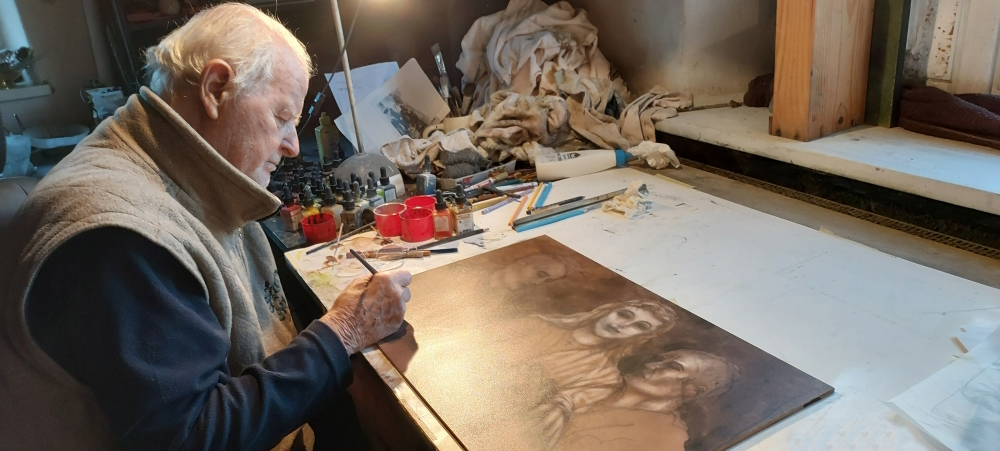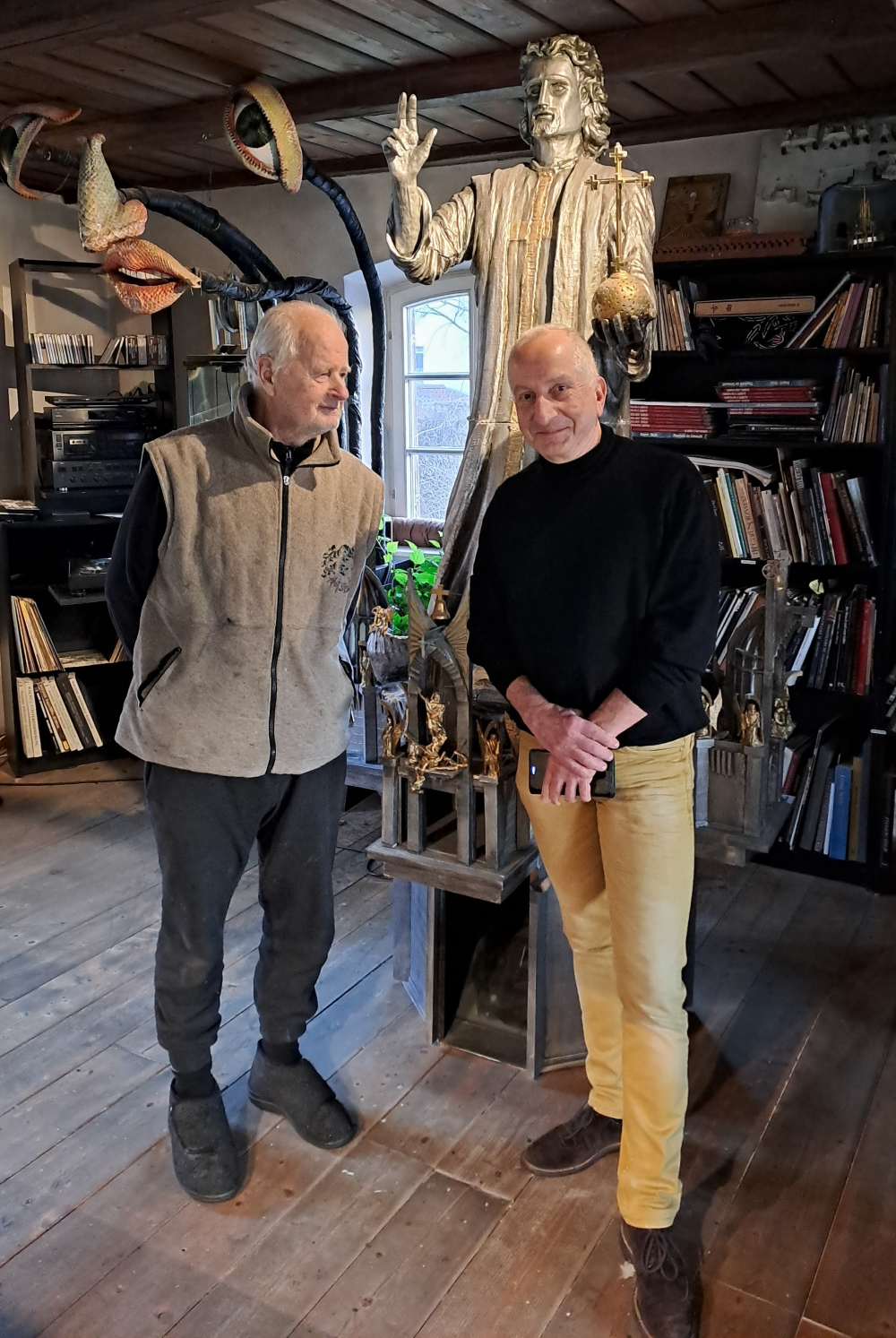Angerer, der Aeltere
phantastic realism painter / sculptor / architect
Germany
„The Neverending Story II: The Next Chapter“. For the movie-sequel based loosely upon the second half of Michael Ende’s world-famous epic fantasy novel he was the conceptual artist. In particular: the silver city and the Castle of Horok also known as The Seeing Hand, „because its multitude of windows appears like human eyes“ (Wikipedia). This bastion is the stronghold of Xayide the Witch and features lots of spidery vaults. Furthermore the man was in charge of the set design and the costumes for the first ever theatrical version of J.R.R. Tolkien’s „The Little Hobbit“. Creating magical worlds like these is this multi-awarded German’s speciality. He’s one of the international leading artist of Phantastic Realism as well as „one of the most versatile artists of this and the last century“ (donaukurier.de). His detailed paintings are sold worldwide and the Salvation Chapel in Biburg/Bavaria was built according to his designs. The Christian synthesis of architecture, painting and sculpture was praised by Joseph Cardinal Ratzinger (later Pope Benedikt XVI, 1927-2022) in his handwritten greetings as follows: "I congratulate you on the work of art which at last once again represents real sacred art in contrast to so much that only makes visible the decay of the soul in unbelief."
Angerer, der Aeltere
phantastic realism painter / sculptor / architect
Germany

"In art the human being has disappeared from the centre. But I look for the space for imagination." These comments that Ludwig Angerer aka Angerer, der Aeltere (the senior) told to the German daily newspaper ‚Hamburger Morgenpost‘ sum it all up for him. They were spoken two days prior to the first night of the stage-version based on the 1937 book by the legendary „Lord Of The Rings“-author in early February 1994 – an event, this creative was involved in. An obvious choice to engage him for as he’s known being the master of magic pictures. But that’s not all. This artist is a very versatile one: painter, sculptor, architect, author. The basis of his skills is a solid education. Ludwig Angerer (* 7 August 1938 in Bad Reichenhall, Bavaria, Germany) studied architecture in Munich from 1957 to 1961 and then another four years at the Academy of Fine Arts. This was followed by the job as a design architect in the office of architect Alexander von Branca. From 1975 on he was a freelancer. His numerous artistic activities in different genres include the conceptual artistic work for "The Neverending Story II: The Next Chapter". For his participation in the movie the admirer of the poems by Hoelderlin, the key figure of German Romanticism, received the Bavarian Film Award in 1989. A few years later Angerer, der Aeltere designed the tomb for Michael Ende, author of The Neverending Story, who is buried on Munich’s Waldfriedhof.
Angerer’s two- and three-dimensional oeuvre is multifaceted: it includes the poster „Hommage à Dali“ on the occasion of Salvador Dali’s 100th birthday in France 2004, an 113 ostrich-egg-chandelier that’s six meters high, a fantastic ‚transmission castle‘ created from an original Audi-/VW-transmission and countless paintings. His artistic output was exhibited internationally and received numerous awards as well as honours like the „Trophée Apocalypse Dore“ of the European Phantasy Salon (Salon Fantastique Européen/SAFE). That was presented to him in 2008 by the son of the former French president Valéry Giscard d’Estaing. 2014 brought him the silver medal by the jury of Société des Artistes Français (Society of French artists) for his painting „Absoluter Hoellensturz in die Relativitaet“ (Absolute Hellscape Into Relativity).
The founding member of ‚The Centre for Fantastic Artists‘ is a member of Huckleberry Friends, a worldwide creative network, and ‚Ambassador of the Phantasic Universe‘ by the artists‘ group ‚Dalis Erben‘ (Dali’s heirs). He has released various illustrated books – fairy tales, legends and some on the topic of art like the impressive workshow „The return of man to art“ (two volumes in a slipcase, German edition only), others criticial of contemporary culture.
Throughout his career, Angerer, der Aeltere has always appeared as a contentious artist. This is also shown by these quotes from his interview on March, 17th, 2000 in Germany‘s ‚Junge Freiheit‘, "a conservative weekly for the debate": "As far back as we humans can look, all cultures had their origins in myths and religions. The divine, however, was the centre of their existence. Modernity, on the other hand, I am talking here about the art phenomenon of the first half of the last century, believed that without God and traditional continuity it could base itself on nothingness. God, nature and man were driven out of this art.... As Novalis said, "Where no gods rule, ghosts dwell." According to him, an artist "should not, however, in our prosaic time of lack and regression, cease to look towards and point to the centre, so that stick and root remain alive." Modernity, in Angerer's estimation, will always remain alien to the people, for even "the very concept of modernity is an anachronism. Modern implies temporal decay". In this respect, modernity has long since become unfashionable. He therefore sees the artist as a trustee of the timeless, who should be concerned with "addressing the eternal in us." According to his opinion, "the gifted person is obliged to his birth-given disposition and can only see him/herself as an instrument of the Creator, for without elite there is a threat of mediocrity!" Angerer, der Aeltere, counters this with craftsmanship and beauty in the creative process, whereby for him „beauty is never just decoration, but also truth. It comes from the soul of nature and is a creation of God. Beauty contains positives and negatives. Beauty thus also includes the ugly." The best prerequisites for achieving his goal: "Real art must not only be for an elite, but for the whole people!" To do his part, he has also expressed the personal concern in one trenchantly worded sentence on his website: „I see my task in restoring beauty, imagination, mystery and myth to art!“
Ludwig Angerer is married, father of a son and daughter, and lives/works in a historic farmhouse in Biburg, Bavaria, Germany.
Interview February 2023
Magical dreams: restoring beauty, imagination, mystery and myth to art
INTUITION/IMAGINATION
How does intuition present itself to you – in form of a suspicious impression, a spontaneous visualisation or whatever - maybe in dreams?
Intuition always strikes you spontaneously - me often very early in the morning, in what I call 'late sleep'. One is still fresh and the thoughts are not yet influenced by other things then.
Will any ideas be written down immediately and archived?
I don't write anything down, because good ideas come back. They come up more and more often.
?: How do you come up with good or extraordinary ideas?
A good idea has to prove itself, otherwise it might just be an exotic, funny one. A good idea must also have substance. The older you get, the more you know from the start what makes up a good idea. When you're young, you make a lot of mistakes. But in the curse of time you learn very quickly and find out whether it is something substantial or not.
?: Do you feel that new creative ideas come as a whole or do you get like a little seed of inspiration that evolves into something else and has to be realized by endless trials and errors in form of constant developments up until the final result?
This is also a matter of age. Nowadays, when I do something, it always works. As you get older you become more and more accurate. I have never struggled with anything like that. However, I am also not so stubborn by saying "I have a good idea, I have to stick to it". It comes very naturally to me. Either it interests me very much, then I stick with it. There are often such casual ideas that come to you and then you forget about them. Later they suddenly reappear.
What if there is a deadline, but no intuition? Does the first fuel the latter maybe?
I always have an idea, otherwise I don't accept an assigment at all. I have often turned them down because I knew I wouldn't think of anything because it wasn't my subject. When I accept an assigment, something comes up to my mind because the job interests me.
INSPIRATION
What inspires you and how do you stimulate this special form of imaginativeness?
That question is very difficult to answer. You often don't know what inspires you. It usually remains in the subconscious. But at some point you get it out again, like something you have put aside.
At the moment when you think you have a good idea, it is not enough to take it on board as it is. You have to circle it, expose it from all sides. You have to give yourself time for that. That is important. Encircling means the constant return of some thoughts. I have no system here. If there is something that interests you, it always comes up again.
?: How do you filter between ideas worthwhile pursuing and bad ones that you just let go of?
That is another matter of experience. In the past I didn't know how to filter and went after ideas that weren't so good. Today I know immediately whether I have a bright idea or not.
Has it to appeal to you primarily or is its commercial potential an essential factor?
The commercial aspect plays no role at all in my artistic work. However, when I get a commission, I am obliged to take the commercial aspect into account.
Do you revisit old ideas or check what colleagues/competitors are up to at times?
Of course. It happens to me all the time that I pick up older ideas. What colleagues do, however, I don't look at. If it ever gets to that point, then you can stop!
CREATIVITY
Which time/place/environment suits your creative work process the best (tranquillity or pressure) and which path do you take from theory/idea to creation?
Peace and quiet suit my creative work the best. That's why I live in the countryside. Quietness gives one the opportunity to pursue something intensively, without interruption.
At first the idea remains in the mental, without procedures. Then, when I think I know exactly what it should be, I start planning. I am a trained architect. So everything that follows has a system.
What is better in the realization process: speed and force creativity i.e. grasp the magic of the moment, or a slow, ripening process for implementation/elaboration?
That varies case by case. Sometimes it's good to seize the moment, sometimes to take a relaxed approach. There are topics of such a burning importance that you want to realize them right away. Fun always plays a big role in my work. If I particularly enjoy something, I quickly stick to it. On the other hand, there are assignments that one feels obligated to do....
?: Do you have any specific strategies you use when you are feeling stuck creatively?
In a case like that I put the work away until something comes to my mind. But it's like this: you think you're putting something aside, but in your subconscious everything still revolves around this subject. And suddenly you know/have a solution. That‘s amazing.
How important are self-doubt and criticism (by others) during such a process i.e. is it better to be creative on your own, only trust your own instincts, or in a team?
Self-criticism and criticism in general are very important. I am one of those people who have a very strong self-criticism in the factual area - when it comes to something I do. You have to be honest with yourself. That's one of the most important things, because otherwise you do something stupid and don't realise it.
What refers to judging other peoples‘ work of art: I never to do so. I only ever express my own personal opinion - without standing above the person or its work and saying "that's good or that's bad".
Should a creative always remain true to him-/herself including taking risks & going against the flow or must one, for reasons of (commercial) survival, make concessions to the demands of the market, the wishes of clients and the audience’s expectations?
Teamwork only makes sense if there is already an idea. A team cannot have an idea. It always happens in the mind of an individual and be that person part of the team. The team can then manage something very well and very creatively. Ideas, however, are created alone. In the implementation, of course, the situation 'idea against idea' can arise. Then it's important to make a judgement. Often, however, there are ideas of equal value and it's a matter of taking a stand. That is often not so easy - especially in a competition. If it's a matter of good or bad, it is usually easy to find out: there are a number of criteria to be subjected to and then the truth is obvious. But when it comes to the purely artistic, it's an open field.
How is innovation still possible if one has established a distinctive style and, just in case, is it good to be ahead of one’s time even one hazards not being understood?
This question does not arise for me as a representational artist. It is relevant to abstract artists. I come from other times and intend to go to other times. I don't care about the present!
When does the time come to end the creative process, to be content and set the final result free - or is it work-in-progress with an endless possibility of improvement?
I have left some paintings lying around or standing because I knew something was missing. It often took me years to realise what it is/was. Then you work on it you look at it and know that’s finished now. There are the ones that are painted in one go and are finished. With others, that is not the case. But you know whether something is finished. This knowledge is purely intuitive.
?: In case of failure or - worse - a creativity crisis how do you get out of such a hole?
I do not know that, although an exception confirms the rule with me. There is a singular, specific case: I wanted to paint Joseph Cardinal Ratzinger who became Pope Benedict XVI later on. It was the first time in my life that I gave up on a portrait because I could not reproduce the radiance in his face. It was the only time I have failed. He had a holy radiance, a special radiance of light - at least that is how I see it - which I was not able to reproduce. All the portraits I saw of him I disliked. The fact that I was unable to adequately portray this impressive, simply overwhelming man confirmed me in the insight that one cannot do everything.
SUCCESS
Should/can one resist the temptation to recycle a ‘formula’ one’s successful with?
I have never had this problem, because when a topic interests me, I do it. Perhaps one can apply here the criticism "Angerer always paints the same". As a teenager I painted landscapes and portraits. I stopped doing so when I attended the Academy of Fine Arts. Then came modernism. It unsettled me. After seeing paintings by Dali as well as Ernst Fuchs, I knew what to do next. It's a completely different kind of painting than so-called modernism, because each painting is something different.
Is it desirable to create the ultimate/timeless work, but doesn’t “top of the ladder” bring up the question of “what’s next?” i.e. isn’t such a personal peak “the end”?
I don't intend to create an ultimate work. Perhaps it will be, without me knowing it. In this respect, such trains of thought are alien to me too. I only strive to do something as well as possible! In view of greats like Leonardo da Vinci or Michelangelo, who constantly created timeless works of genius for the world, I am very modest and think to myself: if I play just a little bit of a small role, then that's a lot for me. But compared to Kandinsky and whoever else there is in terms of modern artists, I am a giant! In this comparison I am a very good painter, a very good artist - and that's even not difficult!
MY FAVORITE WORK:
"Das grosse Welttheater" (The Great World Theatre), 1982
If I had to choose one work of mine that is representative of all my creations, it would be "The Great World Theatre". It is so comprehensive, because numerous ideas have gone into it. It expresses a lot in terms of content. The following thought inspired me to paint this huge picture in 1982: The representation of a time like ours with a divided Germany is still missing! I would like to depict that artistically. It seemed an obligation to me that a painter/an artist should take up this situation. That is why I created this painting in particular and fortunately I succeeded very well.
